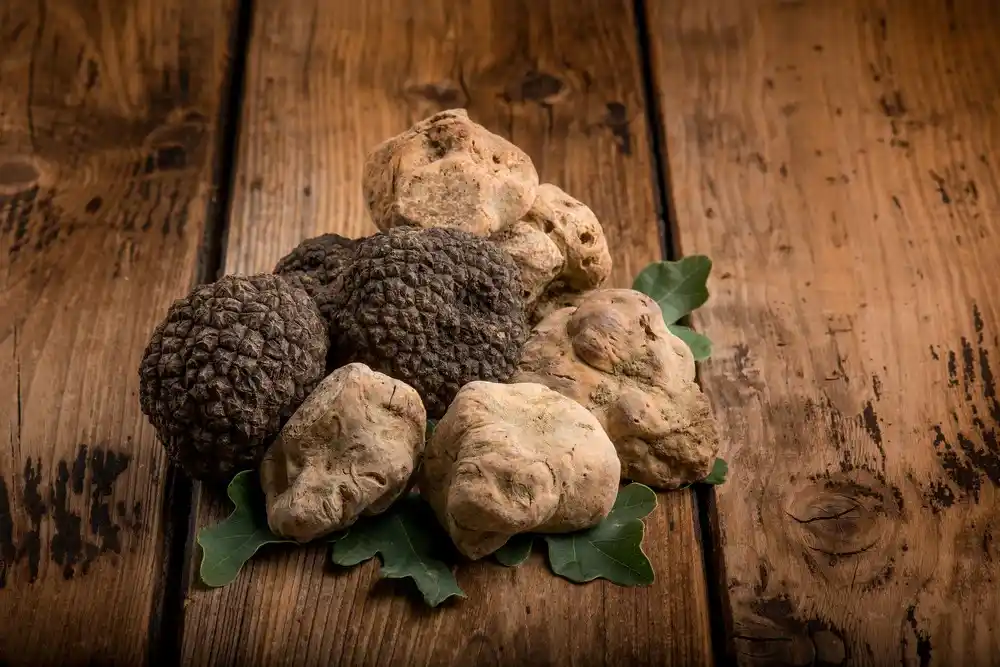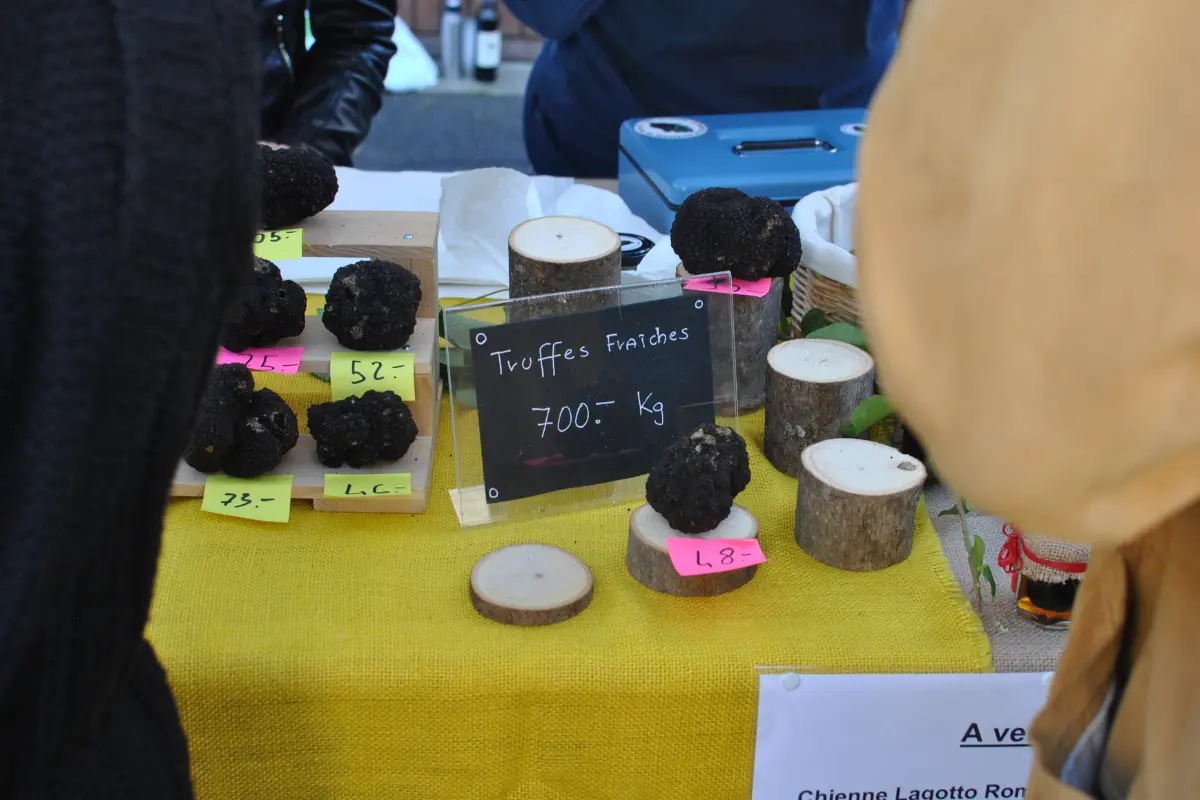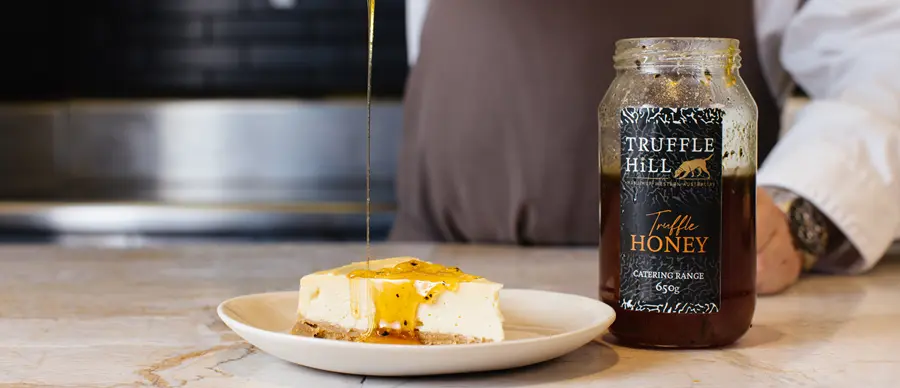
Truffles – the name alone conjures images of luxury, gourmet dishes, and exorbitant prices. But beyond the hype, two main players dominate the truffle scene: white truffle vs black truffle. Though both are highly sought-after fungi, they stand apart in key ways.
Are you curious about which aroma, taste, and culinary applications reign supreme?
Are you wondering which one deserves a place on your next gourmet dish?
If so, this post is for you!
We’ll explore each truffle’s distinct characteristics, appearances, aromas, flavours, seasons, and uses. You’ll learn how their origins and rarity impact their price tags and discover where each shines brightest in the culinary world.
White Truffle vs Black Truffle
Appearance and Origin
White Truffle: Also known as the Alba truffle, it is renowned for its smooth, pale cream to ochre exterior. Originating primarily from the Piedmont region in northern Italy, this truffle symbolises culinary luxury and is often found nestled among the roots of oak, hazel, and poplar trees.
Black Truffle: The black truffle, or the Périgord truffle, contrasts starkly with its rugged, dark exterior. This variety is more widespread – found in regions across France, Italy, Spain, and even Australia, where conditions allow.
Aroma and Flavour
White Truffle: The aroma of the white truffle is unparalleled; a complex bouquet that intertwines musky, garlicky notes with hints of shallots, creating a captivating, intense, and sublime fragrance. This truffle’s flavour is equally sophisticated, offering a delicate blend that enhances dishes without overwhelming them.
Black Truffle: In contrast, the black truffle delivers a robust, earthy aroma. Its flavour is more pronounced, with a deep, musky essence that can stand up to bolder culinary counterparts. This versatility makes the black truffle a favourite for infusing depth into sauces, meats, and cheeses.
Seasonality and Availability
The fascination for truffles is heightened by their seasonality, making each appearance a celebrated event. White truffles are a rare delight with their fleeting season from October to December. Their limited availability results from the precise conditions required for their growth, primarily in Italy’s Piedmont region. This scarcity is a significant factor behind their high price tag and esteemed status in the culinary world.
On the other hand, black truffles offer a broader window of availability. Their season spans from November to March in Europe, with varieties like the Australian truffle extending the season even further, from June to August. This extended season and a wider geographical spread make black truffles more accessible, though no less revered among connoisseurs.
Cooking with White and Black Truffles
Serving White Truffles
The pinnacle of luxury in the culinary world, white truffles are best enjoyed in their most natural state, thinly shaved over dishes. This method of serving preserves their delicate and nuanced flavours, allowing the truffle’s aromatic profile to shine through. Ideal over simple yet elegant dishes like fresh pasta, creamy risotto, or soft scrambled eggs, white truffles elevate the dining experience, adding a touch of opulence with each shaving. This approach ensures that the subtle yet profound essence of the white truffle is not lost but instead becomes the highlight of the culinary creation.
Cooking with Black Truffles
Black truffles are renowned for their versatility in both raw and cooked forms, making them a robust ingredient for culinary experimentation. When cooked, black truffles reveal a deeper, more intense flavour profile that can enhance a wide array of dishes. They are commonly incorporated into sauces, infused into oils, or used as a decadent topping for meats, adding a luxurious depth to each bite. The cooking process helps to meld the truffle’s earthy flavours with the dish, creating a rich and complex culinary experience that is both bold and sophisticated.
The Price Tag

With their intoxicating aroma and elusive nature, truffles often command steep prices. But what exactly contributes to this hefty price tag?
Rarity: The crown jewel of truffle costliness is undoubtedly their scarcity. Unlike cultivated mushrooms, truffles rely on complex symbiotic relationships with specific tree roots, making them difficult to find and cultivate en masse. With their fleeting October-December season, white truffles take the rarity crown, explaining their astronomical prices. Black truffles, while more available, still face seasonal limitations and the challenges of finding them amidst vast underground ecosystems.
Seasonality: Adding another layer to the price puzzle is the limited window to harvest these treasures. White truffles, available only for a few months each year, become even more desirable due to their fleeting presence. Black truffles, with longer seasons depending on the species, offer some relief, but their seasonality still contributes to their value.
Labour of Love: Finding truffles is no walk in the park. Trained dogs or pigs with keen noses are often employed to sniff out these hidden gems, adding a skilled and dedicated element to the hunt. The delicate process of unearthing truffles without damaging them further necessitates careful hand-harvesting, increasing the labour involved and, consequently, the cost.
Perceived Value: Beyond these tangible factors, the price of truffles also reflects their perceived value. They have long been associated with luxury, gourmet dining, and a touch of exclusivity. This perception, fueled by their rarity and unique flavour profile, further elevates their price tag in the eyes of discerning consumers and chefs.
So, are truffles worth the price?
That’s a subjective question. For some, the intense flavour experience, the touch of sophistication, and the rarity justify the cost. For others, more readily available ingredients might offer similar satisfaction.
Which is more expensive?
With their extreme rarity and fleeting season, white truffles typically hold the top spot as the most expensive truffle. Black truffles, while still commanding premium prices, vary in cost depending on the species and their specific seasonality.
Conclusion
As we conclude our journey through the rich and luxurious world of truffles, it’s clear that both white and black varieties offer unique and unparalleled culinary experiences.
From the delicate, aromatic elegance of white truffles to the bold, earthy intensity of black truffles, there’s a truffle to suit every palate and dish.
For enthusiasts eager to explore further, we invite you to discover our exquisite truffle products or embark on an unforgettable truffle hunting adventure. Experience the pinnacle of culinary luxury by visiting Truffle Hill’s website, where you can enhance your dishes with premium truffle products or book an exciting truffle hunt.



